A Smart Building Fire and Gas Leakage Alert System with Edge Computing and NG112 Emergency Call Capabilities
Abstract
:1. Introduction
1.1. Exisitng Challenges in Smart Cities
1.2. Description of the Current State-of-the-Art
1.2.1. Fire and Gas Leakage Detection Systems
1.2.2. Edge Computing
1.2.3. Emergency Calls
1.3. Our Contribution
- It is an embedded system that adopts a low cost and small-size multisensor (temperature, humidity, smoke, flame, CO, LPG, and CNG) scheme in a Wireless Sensor Network (WSN) manner, ensuring reliable and expanded detection coverage of fire and gas leakage.
- It is integrated with the proposed edge computing platform, namely, the Distributed Edge Computing Internet of Things (DECIoT). The DECIoT is a scalable, secure, flexible, fully-controlled, and potential interoperable and modular open-source framework that ensures information sharing (raw measurements from the sensors and/or fire and gas leakage alerts) with other platforms or systems (utilizing proper middleware). Through this approach, optimal use of IoT nodes is ensured.
- Once a fire or gas leak is detected, an NG112 emergency call is carried out through the terms of a Common Alerting Protocol (CAP) message (fully automatically or upon confirmation from a COP operator or decision-maker) to a PSAP. In this study, the PSAP was simulated as an individual workstation considered to be located on a stakeholder’s premises. Finally, the PSAP operator is able to request values from the SB112 system for monitoring reasons (e.g., the last fifteen values reported by the sensors during an event or operation).
2. Materials and Methods
2.1. Proposed Methodology
- Real time measurements, timely fire and gas leak detection, and generation of associated alerts. The ability of fires or gas leaks in buildings to spread extremely quickly makes their detection and suppression at an early stage a necessity. Such time-critical applications demand low-latency access to devices at the edge of the network, as well as the ability to perform rapid computations in order to take immediate decisions. Thus, the continuous and stable operation of the system is necessary in order to prevent fire from spreading, or unwanted situations associated with gas leakage.
- For optimal use of IoT nodes and interactive control, the SB112 system is able to perform and operate autonomously for prolonged periods of time, perform complex tasks depending on the use case, and to acquire measurements through commands either from specific nodes or from all of them. Thus, an optimal configuration is deployed providing automation, remote control, wireless data transferring, and the ability to form scalable networks. The proposed DECIoT provides flexibility, modularity, and potential adaptiveness to incorporated nodes such the ones described in this paper (i.e., with embedded fire and gas leakage sensors) as well as to nodes with any other type of sensors (e.g., a camera) or legacy systems. Thus, the DECIoT is able to provide potential support in an interoperably and to integrate information from heterogeneous sources.
- The SB112 system is highly scalable. The edge gateway is capable of supporting a large number of sensor nodes of any kind. Thus, by creating a network of edge gateways, each with its own sensors, the system can scale quickly and easily. It can cover large areas and handle a variety of different sensor types and measurements, which makes it capable of detecting various emergency conditions. Therefore, it can be applied to multiple use cases.
- For secure operation, recent advances in sensing technologies and data collection mechanisms make feasible the deployment of vast sensor networks that can potentially become intrusive and violate established regulations (e.g., GDPR). Edge computing frameworks are able to keep processing to the edge of the network, avoiding the indiscriminate transmission and storage of sensitive information such as image and video recordings. Although the SB112 system described in this paper does not collect and process image or video recordings, the measurements that it collects can be considered confidential, e.g., in the case of monitoring critical buildings or infrastructure. For this reason, the DECIoT incorporates a security mechanism (that is easy to enable or disable) in order to communicate with the relevant interfaces.
- The SB112 considers several crucial actors involved in emergency situations, such as sensors, IoT devices (sensor nodes and edge gateway), the COP operator of the city authority which manages the smart city platform, and the PSAP with its corresponding operator. Hence, the use case includes the following steps: (i) the SB112 is installed to infrastructure or a building and makes constant measurements of indoor air quality from its multiple sensors in a continuous operation manner; (ii) the SB112 detects an abnormal situation (fire or gas leak); (iii) the SB112 system initiates a fully automatic NG112 emergency call to a PSAP; (iv) the PSAP operator receives the NG112 emergency call; and (v) the PSAP operator requests values from the SB112 system. The above use case can be enriched in the case that a COP operator exists. The necessary condition is that the smart city platform and the SB112 system use the same middleware. Thus, once the SB112 detects an abnormal situation, the COP operator receives the relevant alert through the smart city platform. Then, the COP operator confirms the emergency event (or not) and provides an event response. In the case that the COP operator marks the alert as a false positive, this action terminates the use case. In case that the COP operator marks the alert as a true positive, the SB112 system receives the ‘alert accepted’ response and initiates an NG112 emergency call to the PSAP. It should be noted that the SB112 system ought to be pre-configured (i.e., to either make a fully automatic NG112 call or to make an NG112 call upon confirmation from the COP) depending on the final involved actors.
2.2. Hardware Components
2.3. Distributed Edge Computing IoT Platform (DECIoT)
- The Device Service Layer acts as an interface between the system and physical devices, and is tasked with the functionality of collecting data and actuating the devices with commands. It supports multiple protocols for communication through a set of device services (MQTT Device Service, REST Device Service, Virtual Device Service) and an SDK for creating new device services. In the SB112 system, the MQTT Device Service was used to receive information (i.e., raw measurements) from the sensor nodes. Between the sensor nodes and the MQTT Device Service, there is an MQTT broker.
- The Core Services Layer is at the center of the DECIoT platform and is used for storing data and for commanding and registering devices. The Core Data Service is used for storing data, the Command Service initiates all the actuating commands to devices, and the Metadata Service stores all the details for the registered devices. Specifically, the Metadata Service manages information about devices connected to and operated by the DECIoT, knows the type and organization of data reported by the devices, and knows how to command the devices. This microservices are implemented with the use of Consul, Redis, and adapters developed with the Go programming language for integration with all other microservices. In the SB112 system, all of the above microservices are exploited.
- The Support Services Layer includes microservices for local/edge analytics and typical application duties such as logging, scheduling, and data filtering. The Scheduling Service is a microservice capable of running periodic tasks within DECIoT (for example, cleaning the database of the Core Data Service each day) and is capable of initiating periodic actuation commands to devices using the Command Core Service; this is an implementation in Go that exploits features of Consul and Redis. The Rules Engine Service performs data filtering and basic edge data analytics; Kuiper is used in this microservice. The Logging Service, a Go language implementation, is used for logging the messages of other microservices. In the SB112 system, the Rules Engine microservice was used in order to generate and trigger alerts using raw measurements from the sensor nodes. Here, selected thresholds are considered to generate and trigger the relevant alerts; see Section 3.1.
- The Application Services Layer consists of one or more microservices with the functionality of communicating with external infrastructure and applications. Application Services are the means by which data are extracted, transformed, and sent from the DECIoT to other endpoints or applications. Using this layer, the DECIoT can communicate with a variety of middleware brokers (e.g., MQTT, Apache Kafka) or REST APIs with the goal of reaching external applications and infrastructure. At the same time, the support of an SDK allows the implementation of new application services that fit the use case. For the SB112 system, two application services were implemented, the NG112 application service and the Middleware application service. The NG112 application service is used for two purposes: (i) to send alerts to the middleware, and (ii) to initiate an NG112 emergency call to a PSAP. The Middleware application service is used to send the information received from the Core Data Service to the middleware (i.e., raw measurements from the sensor nodes). Between the NG112 application service and the PSAP, a REST Interface exists.
2.4. NG112 Emergency Call Component and PSAP
3. Results
3.1. Experimental Parameters and Setting
3.2. Experiment
3.3. Installation of SB112 System in Indoor Buildings and Infrastructure
4. Conclusions
Author Contributions
Funding
Institutional Review Board Statement
Informed Consent Statement
Data Availability Statement
Acknowledgments
Conflicts of Interest
References
- Zanella, A.; Bui, N.; Castellani, A.; Vangelista, L.; Zorzi, M. Internet of Things for Smart Cities. IEEE Internet Things J. 2014, 1, 22–32. [Google Scholar] [CrossRef]
- New Waves of IoT Technologies Research—Transcending Intelligence and Senses at the Edge to Create Multi Experience Environments. SINTEF. Available online: https://www.sintef.no/publikasjoner/publikasjon/1896632/ (accessed on 11 January 2022).
- Mobin, M.I.; Abid-Ar-Rafi, M.; Islam, M.N.; Hasan, M.R. An Intelligent Fire Detection and Mitigation System Safe from Fire (SFF). Int. J. Comput. Appl. 2016, 133, 1–7. [Google Scholar]
- Bhoi, S.K.; Panda, S.K.; Padhi, B.N.; Swain, M.K.; Hembram, B.; Mishra, D.; Mallick, C.; Singh, M.; Khilar, P.M. FireDS-IoT: A Fire Detection System for Smart Home Based on IoT Data Analytics. In Proceedings of the 2018 International Conference on Information Technology (ICIT), Bhubaneswar, India, 19–21 December 2018; pp. 161–165. [Google Scholar] [CrossRef]
- Li, Z.; Liu, J.; Guo, C.; Li, S.; Li, L.; Xu, L. Design of Smoke Detection and Alarm System Based on LoRa. In Proceedings of the 2020 Chinese Automation Congress (CAC), Shanghai, China, 6–8 November 2020; pp. 5086–5090. [Google Scholar] [CrossRef]
- Jang, H.-Y.; Hwang, C.-H. Obscuration Threshold Database Construction of Smoke Detectors for Various Combustibles. Sensors 2020, 20, 6272. [Google Scholar] [CrossRef] [PubMed]
- Birajdar, G.S.; Singh, R.; Gehlot, A.; Thakur, A. Development in building fire detection and evacuation system-a comprehensive review. Int. J. Electr. Comput. Eng. (IJECE) 2020, 10, 6644–6654. [Google Scholar] [CrossRef]
- Jadon, A.; Omama, M.; Varshney, A.; Ansari, M.S.; Sharma, R. FireNet: A Specialized Lightweight Fire & Smoke Detection Model for Real-Time IoT Applications. arXiv 2019, arXiv:1905.11922. [Google Scholar]
- Rodriguez-Sanchez, M.; Fernández-Jiménez, L.; Jiménez, A.; Vaquero, J.; Borromeo, S.; Lázaro-Galilea, J. HelpResponder—System for the Security of First Responder Interventions. Sensors 2021, 21, 2614. [Google Scholar] [CrossRef]
- Wu, L.; Chen, L.; Hao, X. Multi-Sensor Data Fusion Algorithm for Indoor Fire Early Warning Based on BP Neural Network. Information 2021, 12, 59. [Google Scholar] [CrossRef]
- Rehman, A.; Qureshi, M.A.; Ali, T.; Irfan, M.; Abdullah, S.; Yasin, S.; Draz, U.; Glowacz, A.; Nowakowski, G.; Alghamdi, A.; et al. Smart Fire Detection and Deterrent System for Human Savior by Using Internet of Things (IoT). Energies 2021, 14, 5500. [Google Scholar] [CrossRef]
- Khan, M.M. Sensor-Based Gas Leakage Detector System. Eng. Proc. 2020, 2, 28. [Google Scholar] [CrossRef]
- Swetha, S.V.; Swetha, G.N. LPG/CNG Gas Leakage Detection and Prevention using IoT. Int. Res. J. Eng. Technol. 2021, 8, 4. [Google Scholar]
- Nembhnani, J.; Yadav, A.; Biswas, S. Developing an intelligent fire alarming, monitoring and rescuing system using UAV. Int. Arch. Photogramm. Remote Sens. Spat. Inf. Sci. 2020, 43, 409–414. [Google Scholar] [CrossRef]
- Fonollosa, J.; Solórzano, A.; Marco, S. Chemical Sensor Systems and Associated Algorithms for Fire Detection: A Review. Sensors 2018, 18, 553. [Google Scholar] [CrossRef] [Green Version]
- Avgeris, M.; Spatharakis, D.; Dechouniotis, D.; Kalatzis, N.; Roussaki, I.; Papavassiliou, S. Where There Is Fire There Is SMOKE: A Scalable Edge Computing Framework for Early Fire Detection. Sensors 2019, 19, 639. [Google Scholar] [CrossRef] [Green Version]
- Ilayarani, P.P.; Dominic, M.M. Smart Firefighting System for Smart Cities Adopting Fog/Edge Computing. Int. J. Innov. Technol. Explor. Eng. 2019, 8, 1–7. [Google Scholar]
- Mahgoub, A.; Tarrad, N.; Elsherif, R.; Ismail, L.; Al-Ali, A. Fire Alarm System for Smart Cities Using Edge Computing. In Proceedings of the 2020 IEEE International Conference on Informatics, IoT, and Enabling Technologies (ICIoT), Doha, Qatar, 2–5 February 2020; pp. 597–602. [Google Scholar] [CrossRef]
- AIOTI. The Alliance for the Internet of Things Innovation. Available online: https://aioti.eu/ (accessed on 13 January 2022).
- imthefastlane. The Value of Spatial Information for Emergency Services. EENA. Available online: https://eena.org/wp-content/uploads/GIS-The-value-of-spatial-information-for-emergency-services.pdf (accessed on 28 January 2022).
- Sdongos, E.; Bolovinou, A.; Tsogas, M.; Amditis, A.; Guerra, B.; Manso, M. Next Generation Automated Emergency Calls—Specifying Next Generation Ecall Sensor-Enabled Emergency Services. In Proceedings of the 2017 14th IEEE Annual Consumer Communications & Networking Conference (CCNC), Las Vegas, NV, USA, 8–11 January 2017; pp. 1–6. [Google Scholar] [CrossRef]
- Sedlar, U.; Winterbottom, J.; Tavcar, B.; Sterle, J.; Cijan, J.; Volk, M. Next Generation Emergency Services Based on the Pan-European Mobile Emergency Application (PEMEA) Protocol: Leveraging Mobile Positioning and Context Information. Wirel. Commun. Mob. Comput. 2019, 2019, e1408784. [Google Scholar] [CrossRef]
- Haghi, M.; Barakat, R.; Spicher, N.; Heinrich, C.; Jageniak, J.; Öktem, G.; Krips, M.; Wang, J.; Hackel, S.; Deserno, T. Automatic Information Exchange in the Early Rescue Chain Using the International Standard Accident Number (ISAN). Healthcare 2021, 9, 996. [Google Scholar] [CrossRef] [PubMed]
- The Go Programming Language. Available online: https://go.dev/ (accessed on 10 February 2022).
- Apache Kafka. Available online: https://kafka.apache.org/ (accessed on 26 January 2022).
- Nasiri, H.; Nasehi, S.; Goudarzi, M. A Survey of Distributed Stream Processing Systems for Smart City Data Analytics. In SCIOT 18: Proceedings of the International Conference on Smart Cities and Internet of Things; Association for Computing Machinery: New York, NY, USA, 2018; pp. 1–7. [Google Scholar] [CrossRef]
- Xu, R.; Jin, W.; Kim, D. Enhanced Service Framework Based on Microservice Management and Client Support Provider for Efficient User Experiment in Edge Computing Environment. IEEE Access 2021, 9, 110683–110694. [Google Scholar] [CrossRef]
- Eclipse Mosquitto. 2018. Available online: https://mosquitto.org/ (accessed on 26 January 2022).
- Foundation, T.L. Welcome. Available online: https://www.edgexfoundry.org (accessed on 13 January 2022).
- Cao, K.; Liu, Y.; Meng, G.; Sun, Q. An Overview on Edge Computing Research. IEEE Access 2020, 8, 85714–85728. [Google Scholar] [CrossRef]
- Jin, S.; Sun, B.; Zhou, Y.; Han, H.; Li, Q.; Xu, C.; Jin, X. Video Sensor Security System in IoT Based on Edge Computing. In Proceedings of the 2020 International Conference on Wireless Communications and Signal Processing (WCSP), Nanjing, China, 21–23 October 2020; pp. 176–181. [Google Scholar] [CrossRef]
- Villali, V.; Bijivemula, S.; Narayanan, S.L.; Prathusha, T.M.V.; Sri, M.S.K.; Khan, A. Open-source Solutions for Edge Computing. In Proceedings of the 2021 2nd International Conference on Smart Electronics and Communication (ICOSEC), Trichy, India, 7–9 October 2021; pp. 1185–1193. [Google Scholar] [CrossRef]
- eKuiper-LF Edge. Available online: https://www.lfedge.org/projects/ekuiper/ (accessed on 16 March 2022).
- Mane, S.A.; Nadargi, D.Y.; Nadargi, J.D.; Aldossary, O.M.; Tamboli, M.S.; Dhulap, V.P. Design, Development and Validation of a Portable Gas Sensor Module: A Facile Approach for Monitoring Greenhouse Gases. Coatings 2020, 10, 1148. [Google Scholar] [CrossRef]
- Fakra, D.A.H.; Andriatoavina, D.A.S.; Razafindralambo, N.A.M.N.; Amarillis, K.A.; Andriamampianina, J.M.M. A simple and low-cost integrative sensor system for methane and hydrogen measurement. Sens. Int. 2020, 1, 100032. [Google Scholar] [CrossRef]
- Smart Spaces Safety And Security. Greece. S4AllCities. Available online: https://www.s4allcities.eu (accessed on 9 February 2022).


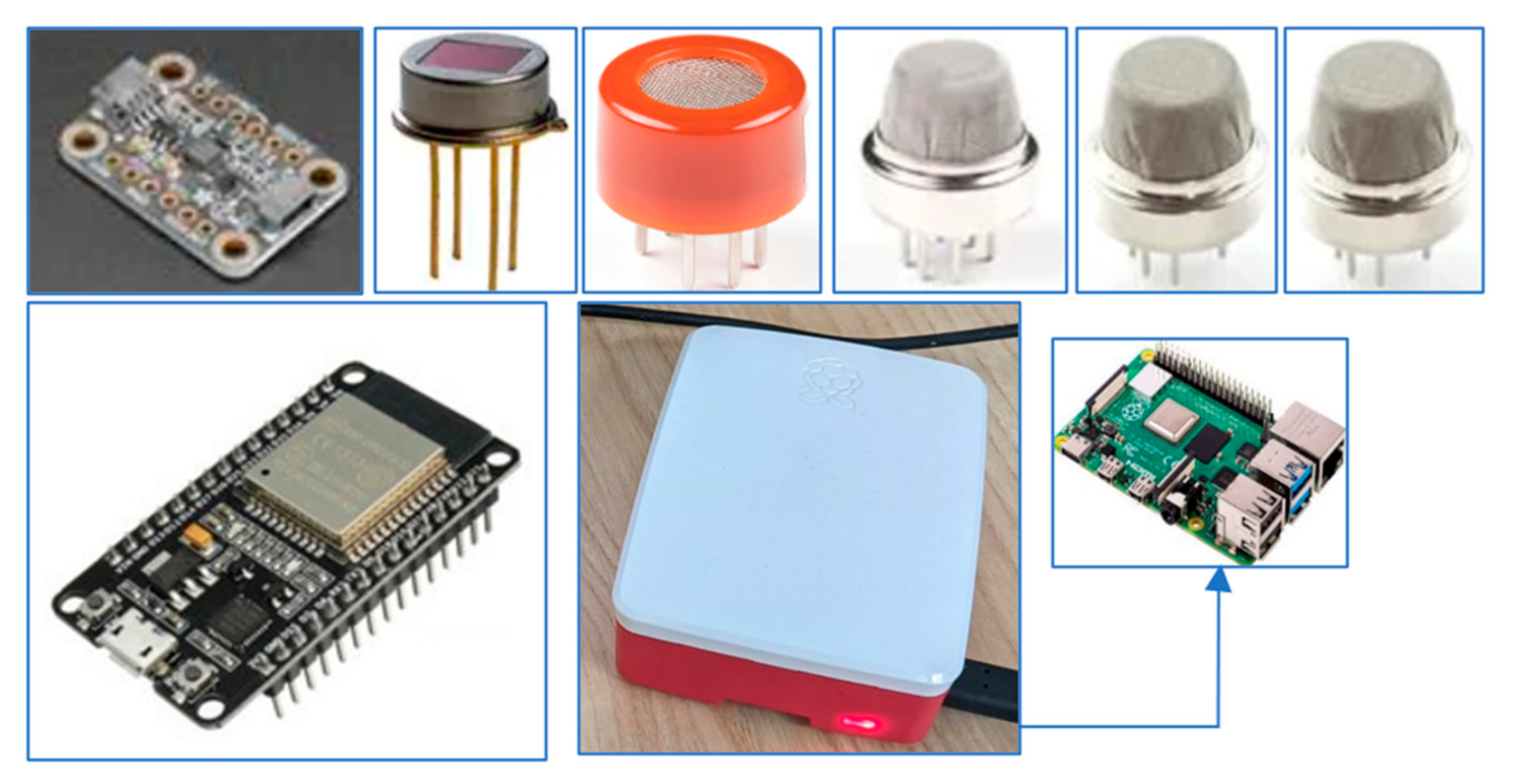
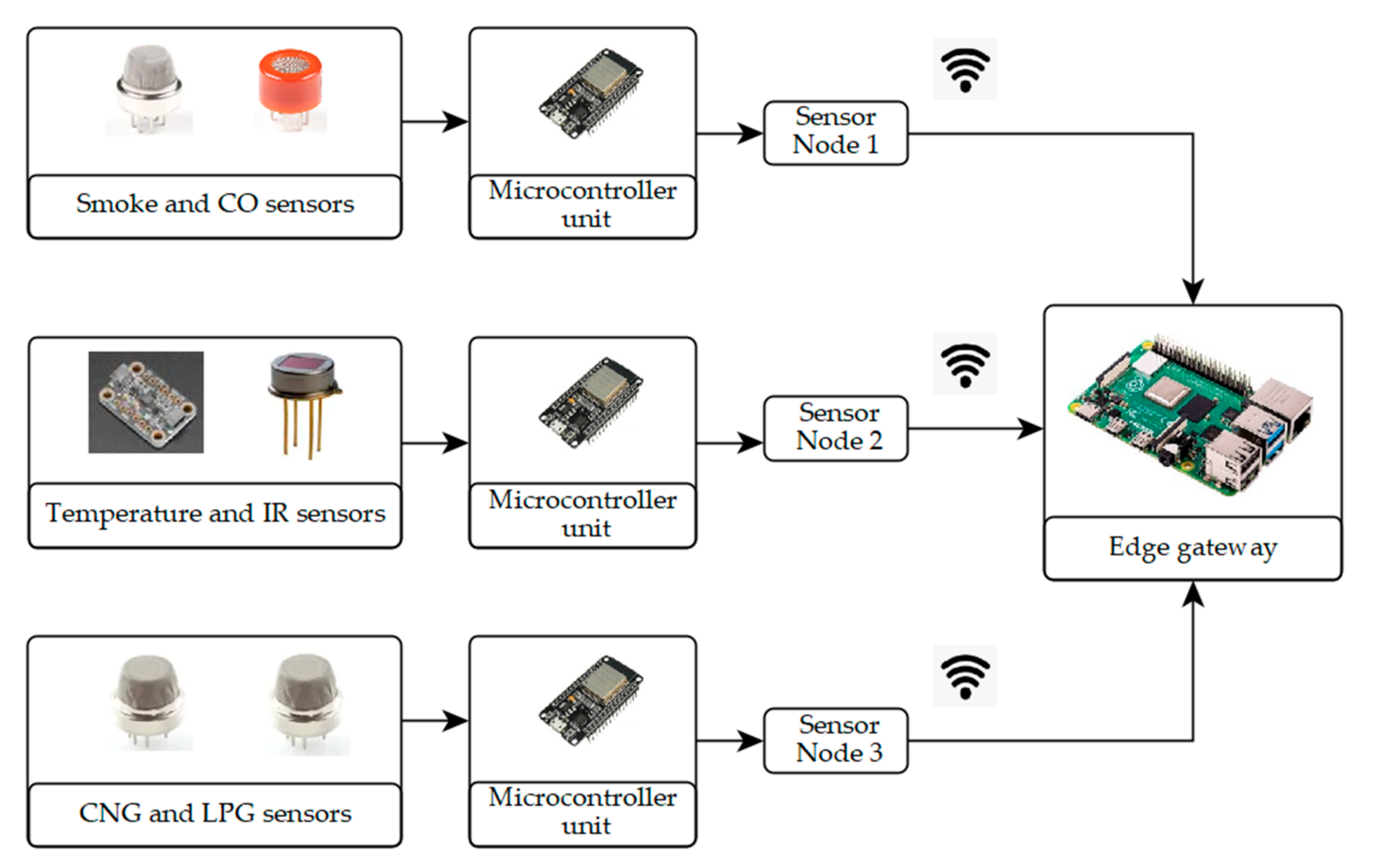

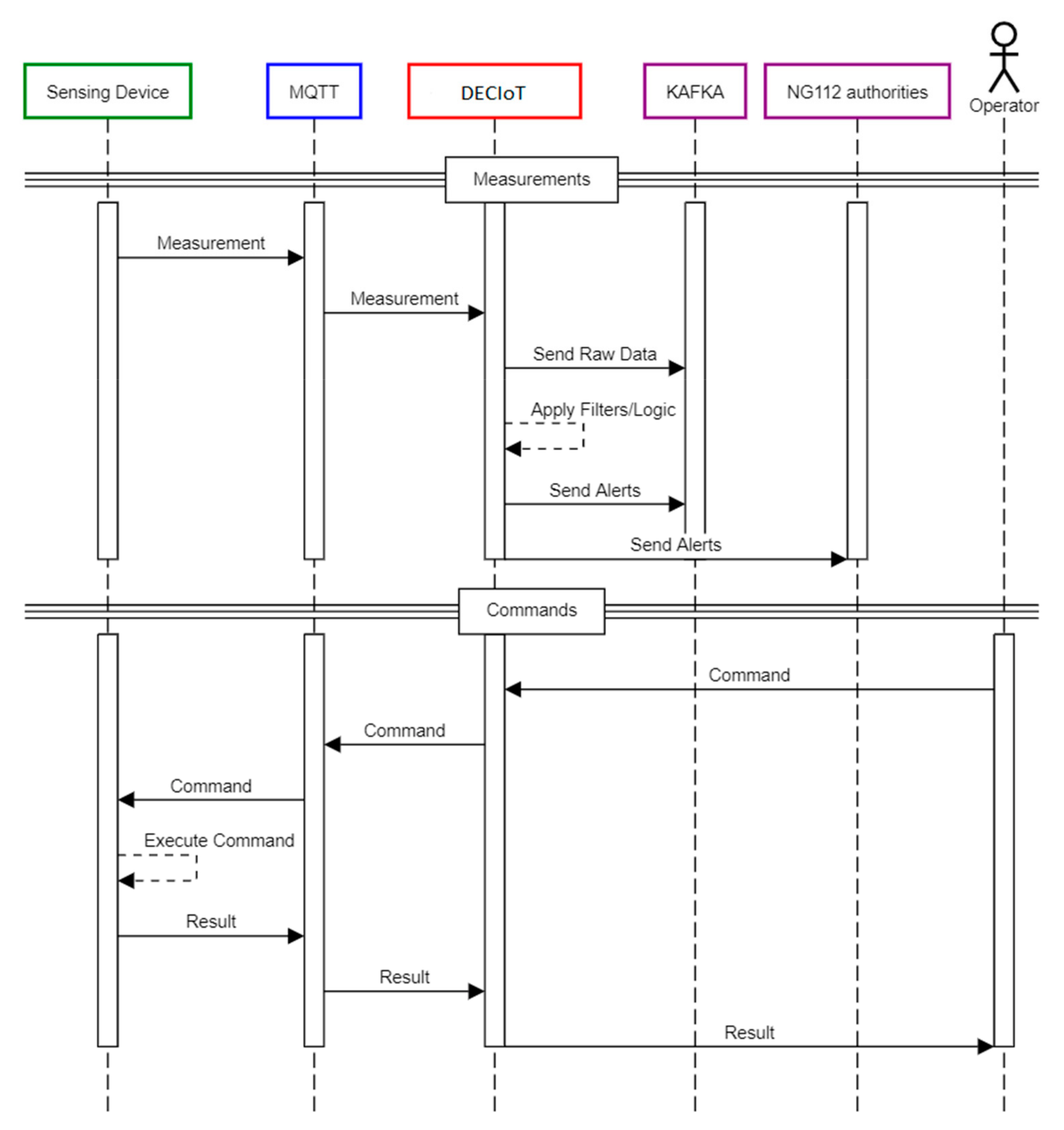

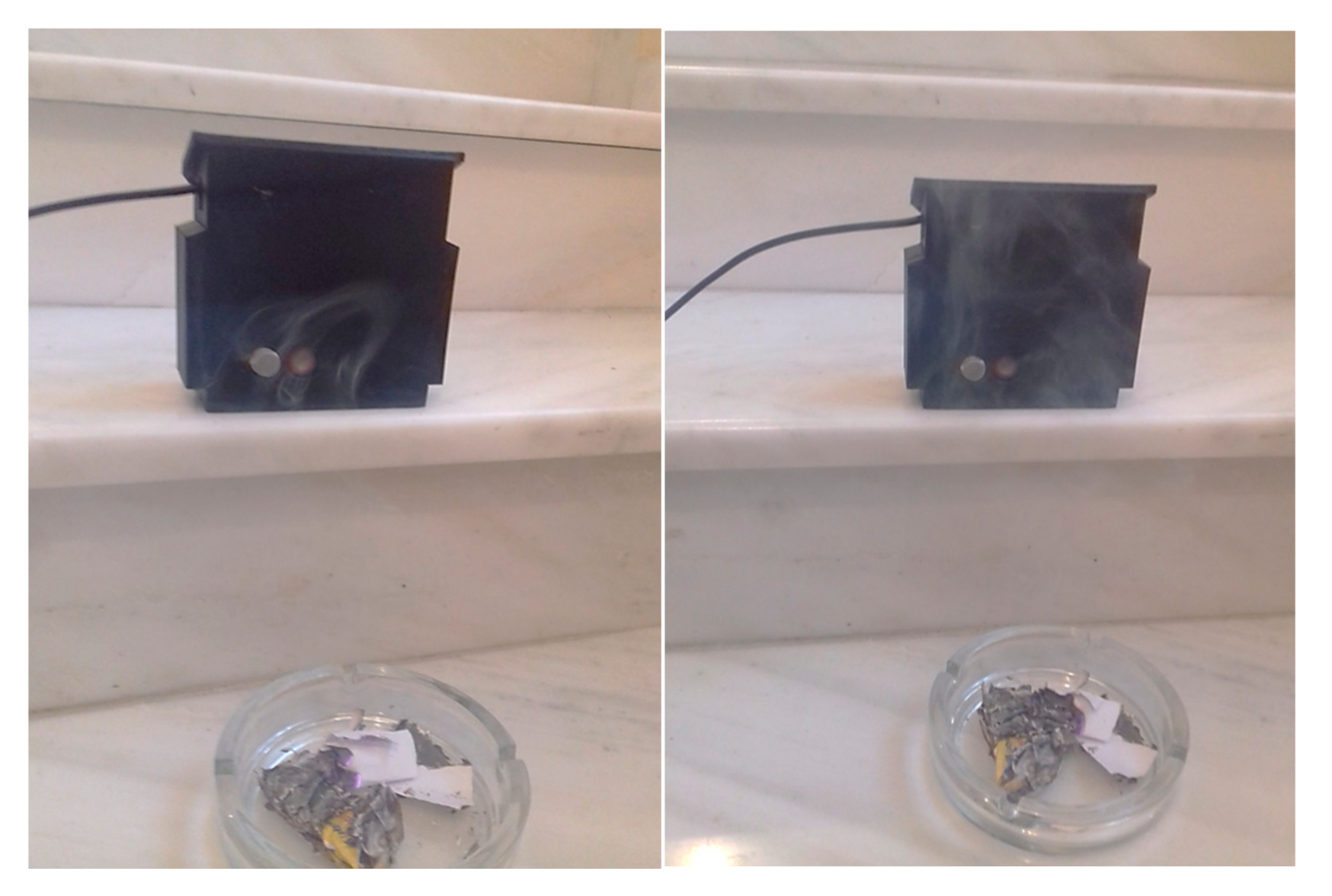
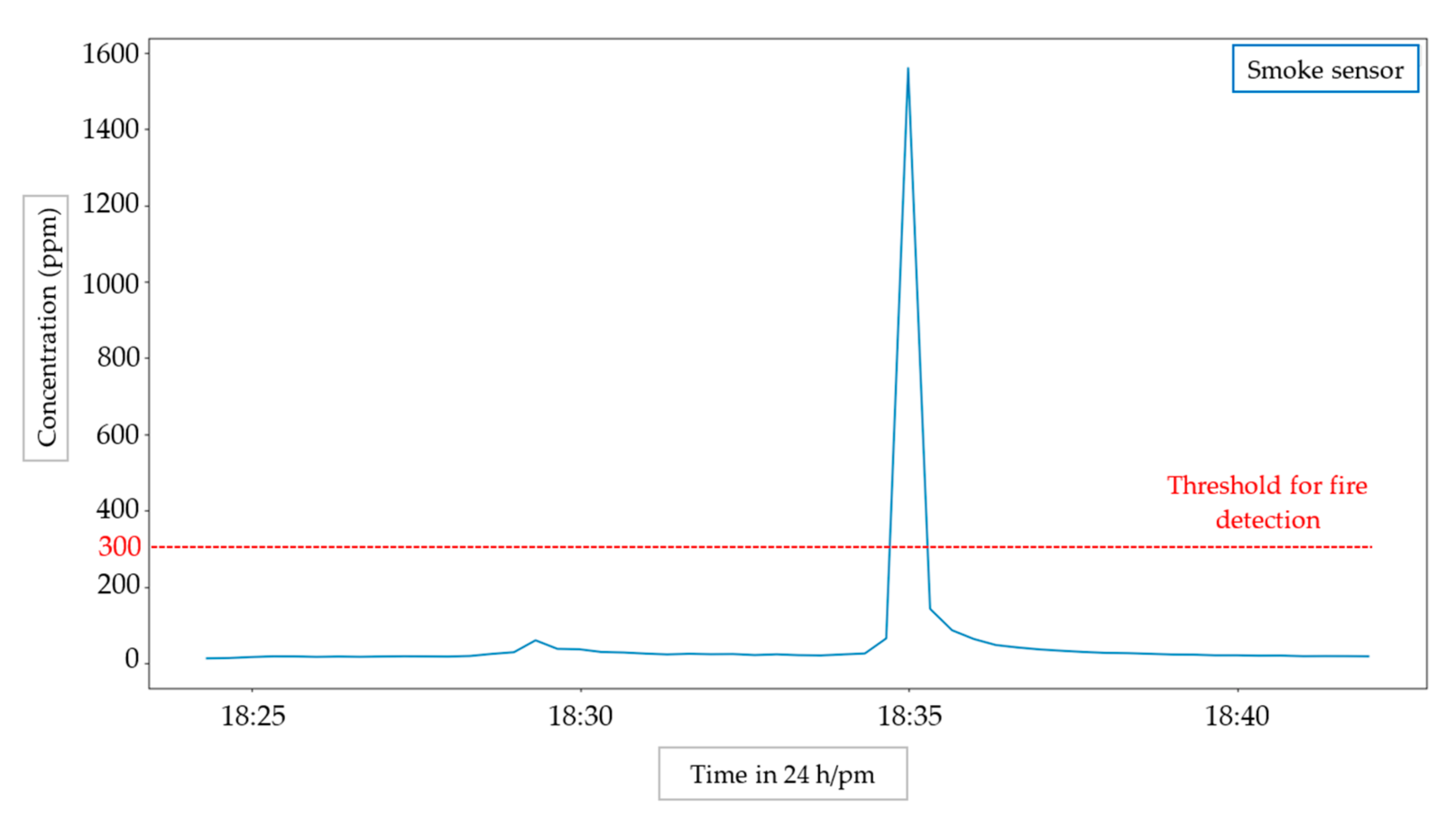
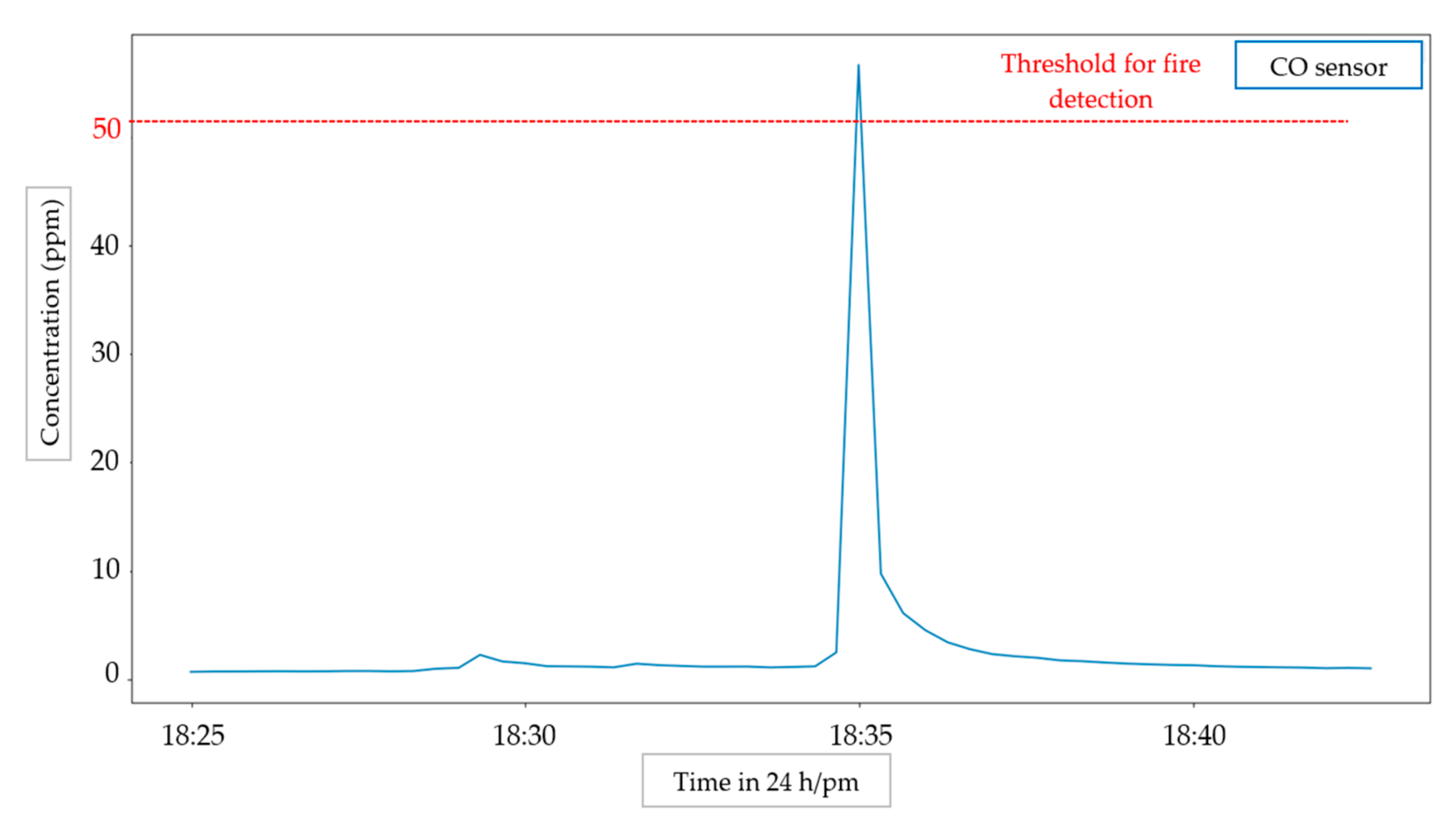


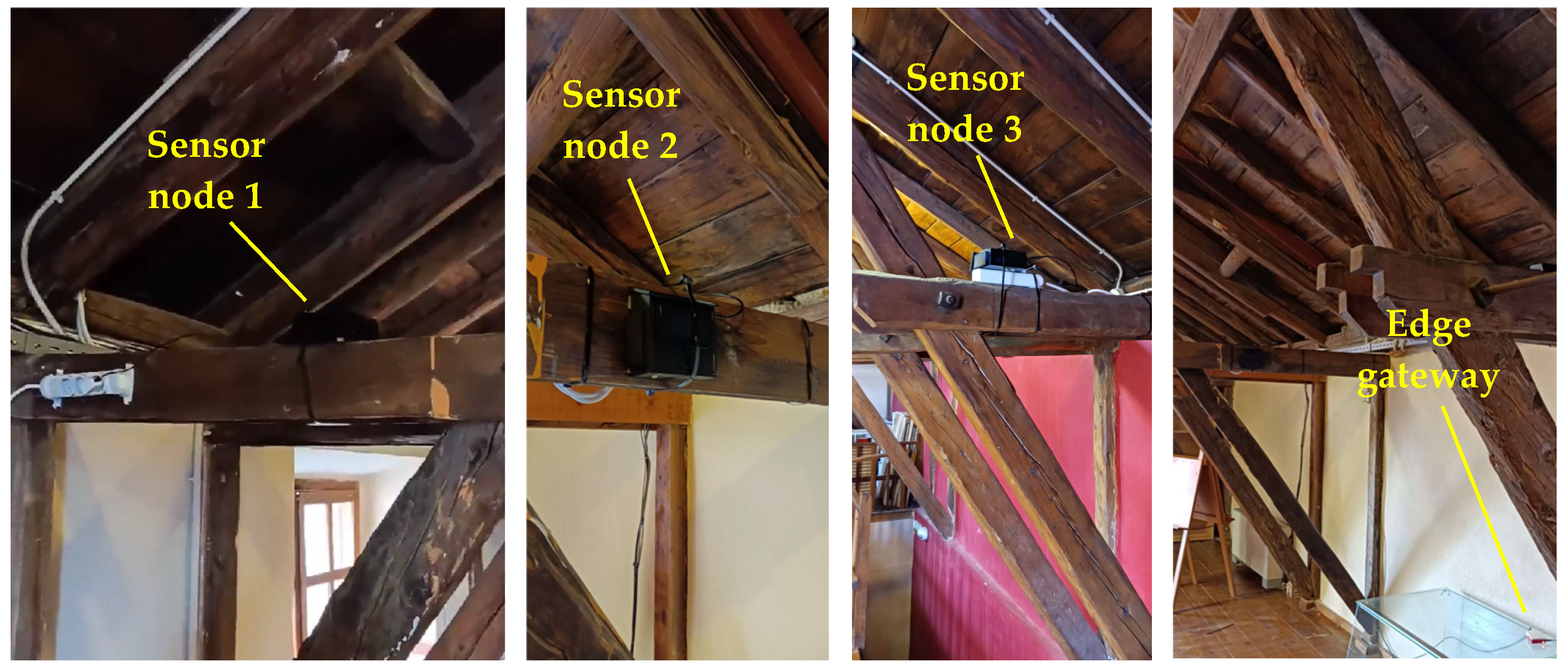
| Sensor | Threshold |
|---|---|
| Temperature | 60 Celsius |
| CO | 50 ppm |
| Smoke | 300 ppm |
| LPG | 2100 ppm |
| CNG | 1000 ppm |
| Sensor Node Id | Physical Integration of the Microcontroller Units with the Sensors | Packaged Sensor Node (Left: Inside; Right: Outside) | |
|---|---|---|---|
| 1 | 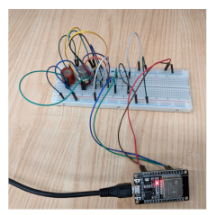 | 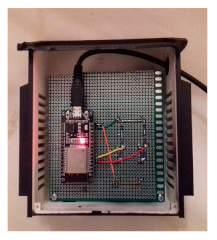 | 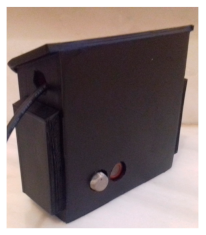 |
| 2 | 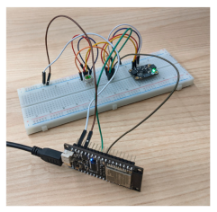 | 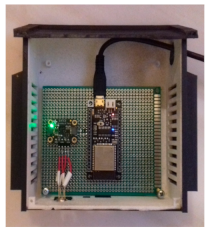 |  |
| 3 | 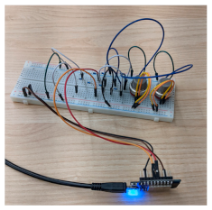 | 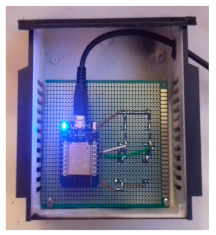 | 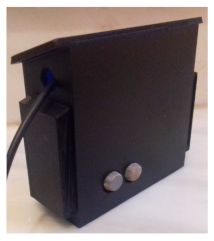 |
Publisher’s Note: MDPI stays neutral with regard to jurisdictional claims in published maps and institutional affiliations. |
© 2022 by the authors. Licensee MDPI, Basel, Switzerland. This article is an open access article distributed under the terms and conditions of the Creative Commons Attribution (CC BY) license (https://creativecommons.org/licenses/by/4.0/).
Share and Cite
Maltezos, E.; Petousakis, K.; Dadoukis, A.; Karagiannidis, L.; Ouzounoglou, E.; Krommyda, M.; Hadjipavlis, G.; Amditis, A. A Smart Building Fire and Gas Leakage Alert System with Edge Computing and NG112 Emergency Call Capabilities. Information 2022, 13, 164. https://doi.org/10.3390/info13040164
Maltezos E, Petousakis K, Dadoukis A, Karagiannidis L, Ouzounoglou E, Krommyda M, Hadjipavlis G, Amditis A. A Smart Building Fire and Gas Leakage Alert System with Edge Computing and NG112 Emergency Call Capabilities. Information. 2022; 13(4):164. https://doi.org/10.3390/info13040164
Chicago/Turabian StyleMaltezos, Evangelos, Konstantinos Petousakis, Aris Dadoukis, Lazaros Karagiannidis, Eleftherios Ouzounoglou, Maria Krommyda, George Hadjipavlis, and Angelos Amditis. 2022. "A Smart Building Fire and Gas Leakage Alert System with Edge Computing and NG112 Emergency Call Capabilities" Information 13, no. 4: 164. https://doi.org/10.3390/info13040164
APA StyleMaltezos, E., Petousakis, K., Dadoukis, A., Karagiannidis, L., Ouzounoglou, E., Krommyda, M., Hadjipavlis, G., & Amditis, A. (2022). A Smart Building Fire and Gas Leakage Alert System with Edge Computing and NG112 Emergency Call Capabilities. Information, 13(4), 164. https://doi.org/10.3390/info13040164








